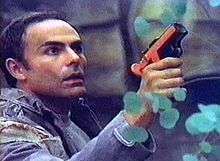Dylan Hunt
Dylan Hunt is the name of two fictional characters created for television by Gene Roddenberry.
Both characters are men who unwittingly move forward in time by hundreds of years, finding themselves trapped in a post-apocalyptic "Dark Age". Each either begins or joins a crusade by a small force of explorer/adventurers to restore civilization.
Genesis II and its sequels
The first Gene Roddenberry projects to feature Dylan Hunt appeared in the 1970s.
Genesis II
In the 1973 made-for-TV film Genesis II, which introduced the character and was intended as a pilot for a potential series, Hunt was played by Alex Cord. Hunt was a NASA scientist who became trapped in suspended animation in 1979, only to awaken 154 years later. CBS, the network that aired Genesis II, rejected Roddenberry's proposed series in favor of the short-lived Planet of the Apes, which also involved time travel and a post-apocalyptic society.
Planet Earth
Because CBS did not pick up "Genesis II", Roddenbery pitched the same idea to ABC. In 1974 ABC aired Planet Earth, a reworked sequel and second pilot as a TV movie. This time, the Hunt character was played by John Saxon.

Strange New World
In 1975, Saxon starred in a third project entitled Strange New World, again aired on ABC. While this production was loosely based on Roddenberry's Dylan Hunt premise, Roddenberry himself chose not to participate. Saxon's character was named Captain Anthony Vico, but the movie shared the same "time travel to a Dark Age" premise of Genesis II and Planet Earth.
Following this trio of productions, the Dylan Hunt concept was revived by Roddenberry's widow, Majel Barrett Roddenberry, this time with great success, a quarter of a century later.
Andromeda
The most completely developed incarnation of Hunt is also the most recent. In the television series Gene Roddenberry's Andromeda, he is the captain of the starship Andromeda Ascendant. In this series he is played by Kevin Sorbo.